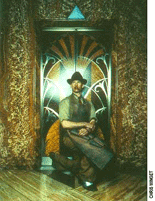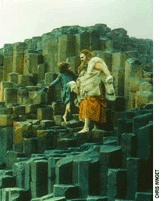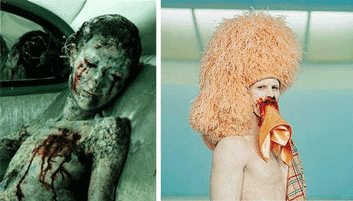Cremaster 3 (Matthew Barney) 2002
 Matthew Barney’s extravagant new art film Cremaster 3 is at once a
tough pill to swallow and a minor miracle of self-expression. Tackling many of
the same themes that Cocteau did in his 1930 masterwork The Blood of a Poet,
Barney ends his five film Cremaster series with a surprisingly coherent and
approachable installment that obviously stands as the series’ magnum opus. I
haven’t lived in New York City long enough to have seen all of Barney’s
series, and he doesn’t make it easy to see them outside of a museum.
Apparently, the only way to obtain a video copy of them involves purchasing one
of the director/artist’s sculptures, which are prominently featured in the
films. The Guggenheim is planning a
retrospective of the series next year, and that exposition should allow me to
fill some of the gaps in my understanding of the series, but I did previously
see Cremaster 2, the fourth film in the series. Though Cremaster 2
was considered a huge step forward in terms of narrative structure and scope,
its story was not nearly as coherent, nor was imagery as powerful as that Barney
presents in his latest film. Like Blood of the Poet, Cremaster 3
is divided into four segments, which show the gradual progression of the man
into the artist. I can’t talk much about its relationship to the rest of the
series (though some images clearly recalled Cremaster 2, particularly
during the demolition derby), but the film is remarkably self-contained. I
can’t analyze the film as great art necessarily, but I can look at it solely
as a film, and by those standards, it’s the most impressive work I’ve seen
so far this year. Frankly, to judge it by the same terms as most films feels
unfair.
Matthew Barney’s extravagant new art film Cremaster 3 is at once a
tough pill to swallow and a minor miracle of self-expression. Tackling many of
the same themes that Cocteau did in his 1930 masterwork The Blood of a Poet,
Barney ends his five film Cremaster series with a surprisingly coherent and
approachable installment that obviously stands as the series’ magnum opus. I
haven’t lived in New York City long enough to have seen all of Barney’s
series, and he doesn’t make it easy to see them outside of a museum.
Apparently, the only way to obtain a video copy of them involves purchasing one
of the director/artist’s sculptures, which are prominently featured in the
films. The Guggenheim is planning a
retrospective of the series next year, and that exposition should allow me to
fill some of the gaps in my understanding of the series, but I did previously
see Cremaster 2, the fourth film in the series. Though Cremaster 2
was considered a huge step forward in terms of narrative structure and scope,
its story was not nearly as coherent, nor was imagery as powerful as that Barney
presents in his latest film. Like Blood of the Poet, Cremaster 3
is divided into four segments, which show the gradual progression of the man
into the artist. I can’t talk much about its relationship to the rest of the
series (though some images clearly recalled Cremaster 2, particularly
during the demolition derby), but the film is remarkably self-contained. I
can’t analyze the film as great art necessarily, but I can look at it solely
as a film, and by those standards, it’s the most impressive work I’ve seen
so far this year. Frankly, to judge it by the same terms as most films feels
unfair.
 It’s tough to name the most dominant theme in a film as densely packed as this
one, but the exploration of the artist’s growth in a world that is hostile
toward his unproductive creativity stood out most to me. Each of the four
segments of Cremaster 3 seems to present a different stage in the
development of its artist. The first segment that we see shows us a relationship
between two giants, presumably father and son. Set on a remote isle, we see the
son sculpting secretly when his father wanders the ocean, bellowing. Upon
returning, the father finds the son’s sculpture and, after failing to gain the
same sustenance from art as the son, is outraged. A fight ensues between the
two, leading to the casting of a giant stone disc into the sea. We see thousands
of similar discs where that one lies, suggesting the encounter has happened
countless times before. Quite by accident, the repeated confrontation seems
accountable for The Giant’s Causeway, a famed Irish landmark. The other
segments of the film play out similarly. Set in the Chrysler Building and the
Cloud Club speakeasy contained within, a horse racetrack, and the Guggenheim
Museum, each of them similarly pits its “hero” (played by Barney himself in
each segment) against the patriarchy that cannot understand his desire to
create.
It’s tough to name the most dominant theme in a film as densely packed as this
one, but the exploration of the artist’s growth in a world that is hostile
toward his unproductive creativity stood out most to me. Each of the four
segments of Cremaster 3 seems to present a different stage in the
development of its artist. The first segment that we see shows us a relationship
between two giants, presumably father and son. Set on a remote isle, we see the
son sculpting secretly when his father wanders the ocean, bellowing. Upon
returning, the father finds the son’s sculpture and, after failing to gain the
same sustenance from art as the son, is outraged. A fight ensues between the
two, leading to the casting of a giant stone disc into the sea. We see thousands
of similar discs where that one lies, suggesting the encounter has happened
countless times before. Quite by accident, the repeated confrontation seems
accountable for The Giant’s Causeway, a famed Irish landmark. The other
segments of the film play out similarly. Set in the Chrysler Building and the
Cloud Club speakeasy contained within, a horse racetrack, and the Guggenheim
Museum, each of them similarly pits its “hero” (played by Barney himself in
each segment) against the patriarchy that cannot understand his desire to
create.

There’s no dialogue in the film, but we still get a good sense of what the
director is trying to say. Clearly, the scale and the opulence of Barney’s
vision are unusual, even in the art world. His films are not at all amateurish,
in the way that much video art is, and it’s made quite obvious that the artist
puts a lot of work into his expression. The movie looks as if Barney himself has
painstakingly sculpted every detail on screen. The director casts himself in the
Chrysler segment as a mason, creating a link between himself and the working
people of the world. We see him reaching out to those who work for a living
(most explicitly to the potato cutter), and we see the amount of work he
requires to complete his obscure tasks (that we can’t quite understand their
purpose seems half the point). It’s no coincidence that the film had its world
premiere on May 1st (May Day – which is used here to reference the worker’s
holiday, a phallic symbol, and one of a multitude of nods to Celtic culture). As
Barney contemplates his artistic process, he celebrates of the ability of all
work to achieve results, culminating in an orgasmic transformation of the
Chrysler building into a Maypole. Though there might be a bit of hubris involved
in Barney’s comparisons of his work to some of the greatest works of
architecture and nature, his willingness to be self-effacing goes a long way
toward accepting those associations.
 Barney’s most overt auto-critique takes place during the Guggenheim segment.
Cast as the “Entered Apprentice” (one of many Masonic references) of the art
world in this segment, he is challenged with the near-indomitable task of
scaling the vertical spire of the museum. On each of the building’s five
floors, a living diorama resides, each apparently reminiscent of one of the
Cremaster films. As the Barney character attempts to maneuver past his
creations, he slyly criticizes his place in the art world that has coddled him.
Throughout, there’s an abundant sense of humor in his images, and the
testosterone-addled climax of the Apprentice’s attempts to scale the building
is at once mordantly funny and a revelation. Unlike Cocteau, who explained most
artistic expression as a rape of childhood trauma (this artist’s trauma is
removed in the dental scene), Barney sees his art as a necessary extension of
his natural male impulse. His violent outburst at the film’s end is at once a
defilement of the hallowed halls of the museum and a justification for being
there in the first place. The series of heavily symbolic images that Barney
presents during the film are at once familiar (in the sense that they contain a
good deal of iconic power) and unworldly (in the sense that no one else would
possibly conceive them). I’ll stop my review here, since to overanalyze them
would probably rob them of much of their intuitive, visceral power, which is
only enhanced by the ever-escalating drone of the soundtrack. Cremaster 3
is an astonishing achievement.
Barney’s most overt auto-critique takes place during the Guggenheim segment.
Cast as the “Entered Apprentice” (one of many Masonic references) of the art
world in this segment, he is challenged with the near-indomitable task of
scaling the vertical spire of the museum. On each of the building’s five
floors, a living diorama resides, each apparently reminiscent of one of the
Cremaster films. As the Barney character attempts to maneuver past his
creations, he slyly criticizes his place in the art world that has coddled him.
Throughout, there’s an abundant sense of humor in his images, and the
testosterone-addled climax of the Apprentice’s attempts to scale the building
is at once mordantly funny and a revelation. Unlike Cocteau, who explained most
artistic expression as a rape of childhood trauma (this artist’s trauma is
removed in the dental scene), Barney sees his art as a necessary extension of
his natural male impulse. His violent outburst at the film’s end is at once a
defilement of the hallowed halls of the museum and a justification for being
there in the first place. The series of heavily symbolic images that Barney
presents during the film are at once familiar (in the sense that they contain a
good deal of iconic power) and unworldly (in the sense that no one else would
possibly conceive them). I’ll stop my review here, since to overanalyze them
would probably rob them of much of their intuitive, visceral power, which is
only enhanced by the ever-escalating drone of the soundtrack. Cremaster 3
is an astonishing achievement.
* * * * Masterpiece
05-19-02
Jeremy Heilman